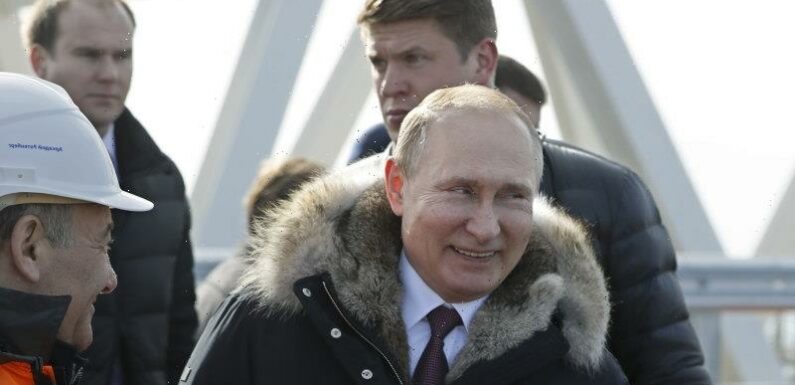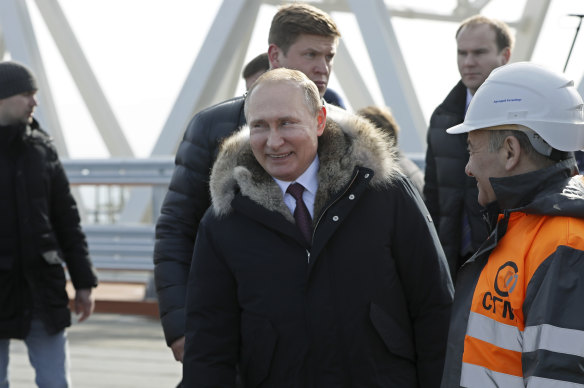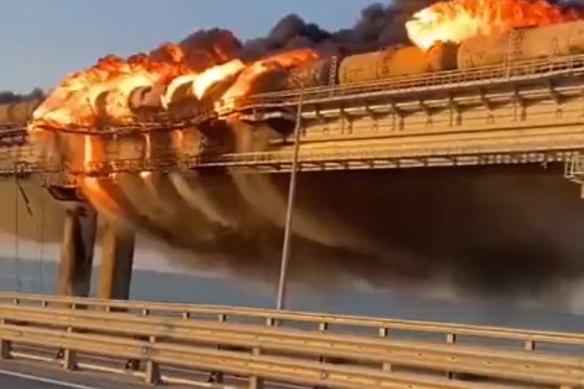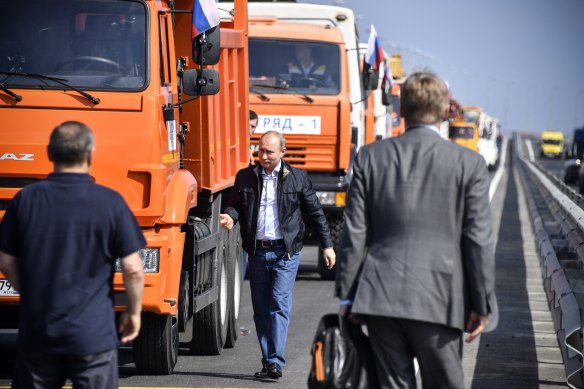
Washington: It was a media extravaganza, Putin-style. At the lead of a small truck convoy, Russian President Vladimir Putin drove an orange dump truck flying Russian flags across a portion of the Crimean Bridge in 2018, proudly inaugurating a 20 kilometres colossus of steel and concrete connecting the Crimean Peninsula he illegally annexed from Ukraine to mainland Russia. At the end of the ride, he was met with cheers and applause.
Even during the reign of the czars, “people dreamed of building this bridge,” Putin boasted. “Finally, thanks to your hard work and talents, this project, this miracle, has come true.”
Russian President Vladimir Putin visits the Kerch bridge linking Crimea to mainland Russia in March 2018.Credit:AP
At about 6am on Saturday (Ukraine time), a giant explosion sent a fireball rolling across Putin’s crown jewel thanks, it could be said, to Putin’s own hard work in launching an invasion of Ukraine in February. Portions of the bridge, among the longest in Europe, could be seen sinking in the water.
While parts of the bridge reportedly reopened to traffic a few hours after the explosion, Kremlin spokesperson Dmitry Peskov said the government didn’t have a timeline for making the bridge fully functional again. Initial information provided by a top Russian law enforcement agency suggested three people had been killed, including a truck driver.
Ukraine, while not taking credit publicly for the blast, had openly promised to attack the bridge as recently as June, calling it a “number one” target because of its strategic importance. The bridge is the sole route for trains and trucks carrying troops and weapons from mainland Russia to Crimea, from where they are funnelled into the grinding war against Ukraine.
It was a strategic disaster and, in part because of Putin’s personal identification with the bridge, a symbolic disaster as well, in a war where symbols matter to the morale of a restive Russian population, on the one hand, and to Ukraine’s Western supporters, for whom highly visible gains for Ukraine are important not only to keep the arms flowing but to persuade citizens that their sacrifices, like high energy prices, are bearing fruit.
Few recent gains were as visible as Saturday’s flames and collapsed roadways spreading across Putin’s bridge. Many have noted that the attack occurred a day after Putin’s 70th birthday.
The Kerch bridge became a symbol of Putin’s mythical personal prowess, his ability to deliver on big infrastructure projects, his ambition to restore Russia to its long-lost greatness. “Even the most ambitious plans can be realised when they are implemented by him,” Kremlin spokesman Dmitry Peskov said in 2018 of the bridge project.
It’s completion also solidified Russia’s illegal annexation of the Crimean peninsula, occupied by the country’s forces since 2014.
After Russia annexed Crimea from Ukraine, Moscow faced a logistical problem. The peninsula was connected by an isthmus only to Ukrainian-controlled territory, meaning cargo and people could arrive only by boat or plane. The idea of a bridge over the Kerch Strait, which would connect Russia to Crimea, became a way to solve that dilemma.
Flames and smoke rise from the bridge connecting the Russian mainland and Crimea.Credit:Twitter
But while Czar Nicholas II and the Soviets had considered building a bridge over the strait in the past, and the Nazis began constructing one before they were ejected from the area during World War II, the idea was regularly questioned for its cost and the challenges of construction, due to weather and terrain.
Among other things, the ground under the strait is composed of silt that made anchoring a bridge difficult. A railway bridge the Soviets built over the strait at the end of World War II was swept away by drift ice a few months after the first train crossed.
Putin decided to proceed with the project anyway, and the bridge’s construction soon became emblematic of Moscow’s commitment to the newly annexed Crimea – a patriotic undertaking reminiscent of Soviet-era dams and canals that became the subject of worker-state propaganda.
To build the bridge, Putin tapped his childhood friend and judo partner, Arkady Rotenberg, who had become a billionaire in the 22 years since Putin took power by receiving large-scale state construction contracts and had been the target of international sanctions. Construction of the 20 kilometre rail and passenger bridge lasted three years and cost some $US4 billion.
Russian President Vladimir Putin drove a truck across the bridge linking Russia and the Crimean peninsula during the opening ceremony in 2018. Credit:AP
“It was a pet project for Putin,” said Simon Schlegel, senior Ukraine analyst for the International Crisis Group. The bridge “made the connection between the Russian mainland and this peninsula that they just claimed to be theirs. It really sort of said that in steel and concrete.”
The annexation of Crimea and the building of the bridge represented “Russia regaining and returning its historical territory” after it had been gifted by Nikita Khrushchev to Ukraine during Soviet times, said Maria Snegovaya, a Postdoctoral Fellow at Georgetown University’s Walsh School of Foreign Service.
Coming amid a string of recent Russian battlefield failures and a reshuffle of top commanders, the explosion is also “essentially just another confirmation” that the trouble he faces now “is unlike anything Putin’s regime has faced over pretty much all of its duration,” Snegovaya said.
Those failures and the latest one, the bridge explosion, prompted renewed public criticism of the conduct of Putin’s war in Russia’s media.
“The stupidest thing to do now is to start reassuring the country that nothing terrible has happened” wrote Komsomolskaya Pravda’s war correspondent, Alexander Kots. The Ukrainians “hit a symbol,” he wrote. “The Crimean bridge is a symbol that the peninsula is securely sealed to Mother Russia and nothing can tear it away from it.”
But it was also a logical target strategically because the bridge, while symbolic, has a military purpose, supplying Russian forces.
Russia, he said, should take a lesson from Ukraine. “Let’s fight more fiercely, for real, without excuses about the impossibility of blowing up the bridge on which the arms are coming from the West. Nothing is impossible, the Ukrainians show us.”
The Washington Post
Most Viewed in World
From our partners
Source: Read Full Article


